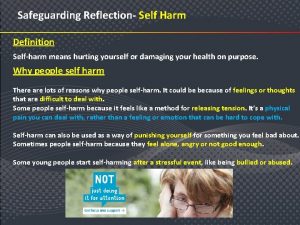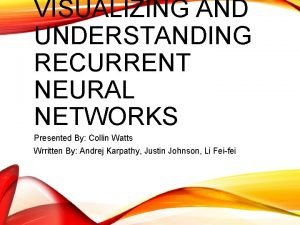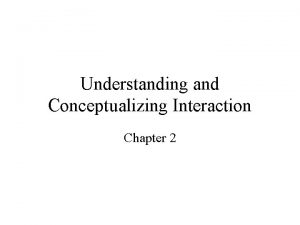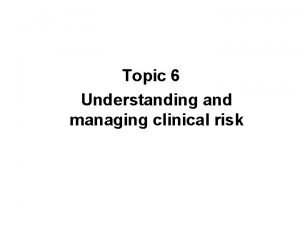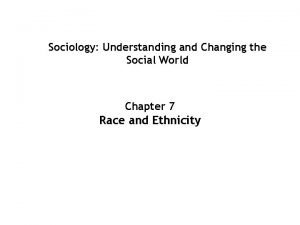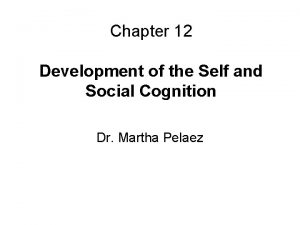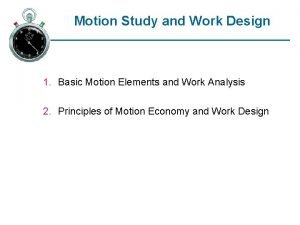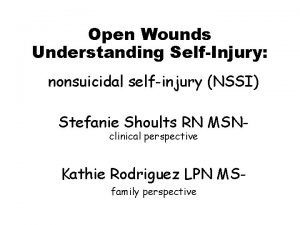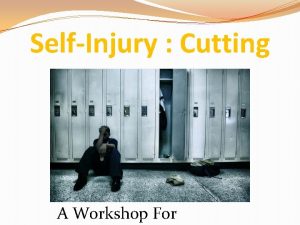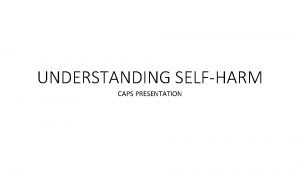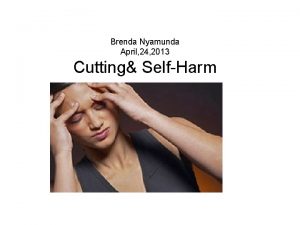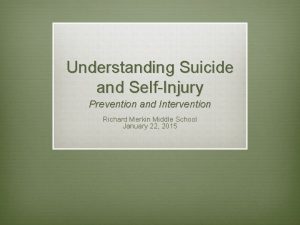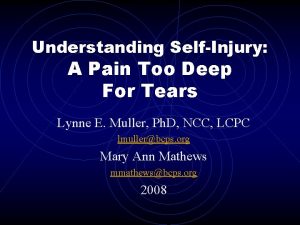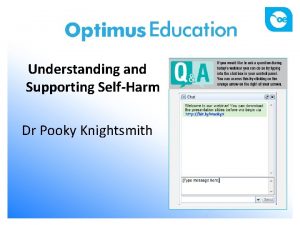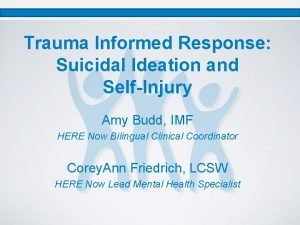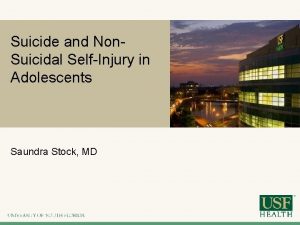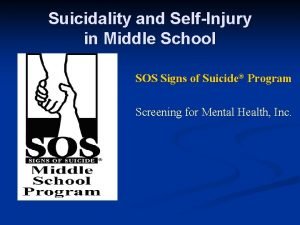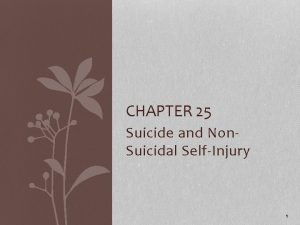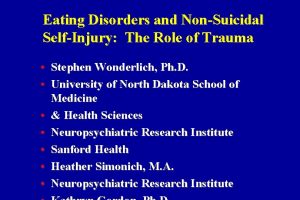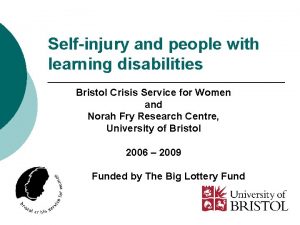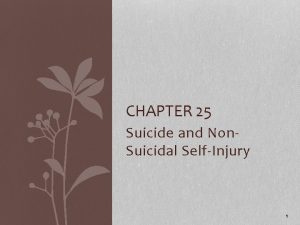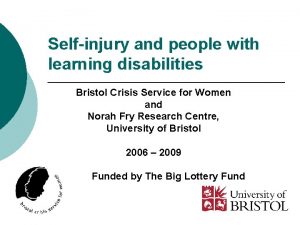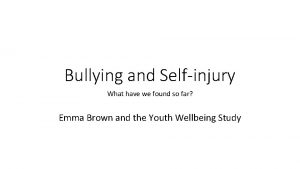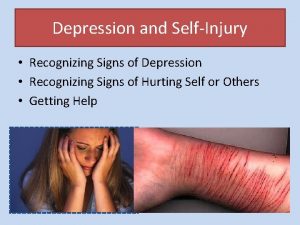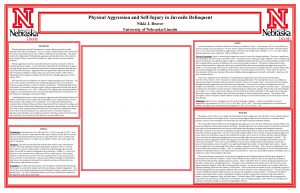UNDERSTANDING SELFHARM What is selfharm Selfharm and selfinjury
























- Slides: 24

UNDERSTANDING SELF-HARM

What is self-harm? Self-harm and self-injury are ways of expressing very deep distress. Often, people don't know why they self-harm. It's a means of communicating what can't be put into words or even into thoughts - it has been described as an inner scream. Afterwards, people feel better able to cope with life again, for a while.

What constitutes self-harm? Cutting or severely scratching your skin Sticking objects into your skin Intentionally preventing wounds from healing Swallowing poisonous substances or inappropriate objects

Burning or scalding yourself Hitting yourself or banging your head Punching things or throwing your body against walls and hard objects

It may also take less obvious forms, including taking unnecessary risks, staying in an abusive relationship, developing an eating problem (such as anorexia or bulimia) or being addicted to alcohol or drugs.

Why do people harm themselves? A person who self-harms is likely to have gone through very difficult, painful experiences as a child or young adult.

At the time, they probably had no one they could confide in, so didn't receive the support and the emotional outlet they needed to deal with it. The traumatic experiences might have involved physical emotional or sexual abuse, or things such as neglect, bullying, harassment, being made homeless, being sent into care, into hospital or to other institutions.

How does self-harming help? There is often an absence of pain during the act of self-harm, rather like the absence of sensation that often occurs during abuse or trauma. The body produces natural painkillers, which numb it and mask the emotions, so that little is felt or realised consciously. A badly traumatised person may end up feeling quite detached from their feelings and their body.

People self-harm as it is a way of: Expressing feelings you can’t put into words Releasing the pain and tension you feel inside Helping you feel in control Distracting you from overwhelming emotions or difficult life circumstances Relieving guilt and punishing yourself Making you feel alive, or simply feel something, instead of feeling numb

The Web of Self-harm

Young People Recent research focusing on young people suggests that 10 per cent of 15 to 16 year olds have self-harmed, usually by cutting themselves, and that girls are far more likely to self-harm than boys. The most common reason is 'to find relief from a terrible situation'. Young people are often under great pressure within their families, from school and among their peers. Many young people report having friends who they know to also self-harm.

The research suggests that young people who self-harm are much more likely to have low self-esteem, to be depressed anxious.

They seem to be facing more problems in life, but may be less good at coping with them. They may retreat into themselves, feeling angry, and blaming themselves. They confide in fewer friends, and tend not to talk to their parents or other adults, or to ask for the help they need.

Suicide and self-harm Self-harm can be about trying to stay alive – a coping mechanism for survival, and to escape from emotional pain. The majority of people who self-harm are not suicidal, but a small minority will intentionally attempt suicide.

Some suicides resulting from self-harming behaviour may be accidental, occurring when someone has hurt themself more than they intended to.

Is self-harming behaviour attentionseeking? Because it can be hard to understand, healthcare professionals, friends and relatives sometimes mistakenly regard people who selfharm with mistrust or fear and see their behaviour as attention-seeking.

Bear in mind those who resort to self-harm may be using the only way they can to communicate their plight and to get the attention, care and comfort they need. However upsetting it may be for those around them, it doesn't necessarily mean it is their intention to hurt others in the process.

What if I am self-harming? The important thing is to find ways to start talking to someone you trust. It could be to a friend, a family member, a professional counsellor, a psychologist or a psychotherapist.

A professional should have the training to listen to you and help you reach your feelings and manage them in a different way. Problems in the present and from the past all need to be addressed. If you can, find someone who specialises in treating people who self-harm.

How can friends and family help? Deal with your own feelings. You may feel shocked, confused, or even disgusted by selfharming behaviors—and guilty about admitting these feelings. Acknowledging your feelings is an important first step toward helping your loved one. Learn about the problem. Understanding why your friend or family member is self-injuring can help you see the world through his or her eyes. Don’t judge. Avoid judgmental comments and criticism—they’ll only make things worse. Remember, the self-harming person already feels ashamed and alone.

Offer support, not ultimatums. It’s only natural to want to help, but threats and ultimatums are counterproductive. Express your concern and let the person know that you’re available whenever he or she needs support. Encourage communication. Encourage your loved one to express whatever he or she is feeling. If the person hasn’t told you about the self-harm, bring up the subject in a caring, non-confrontational way: “I’ve noticed injuries on your body, and I want to understand what you’re going through. ”

Remember that ANYONE can get over selfharming patterns of behaviour with the help of friends, family, and mental health professionals.

A real-life testimonial: “Sometimes three years seems like yesterday and sometimes it seems like forever. Sometimes I look back and it's like I was a totally different person altogether. I think the hardest part for me was learning to forgive myself and stop taking on the guilt and responsibility of my abusers. I had to learn to treat myself good and take care of myself. Forgiveness helped me see myself. . . well. . . as at least tolerable at that time. Now I know there are other ways to let the hurt out and other ways to feel the hurt. . . I just needed someone to teach me. . . I was blessed to find an excellent therapist and she did just that”. [female, age 28, 10 years Self Harm, Master's degree]

References http: //www. mind. org. uk/help/diagnoses_and_c onditions/self-harm http: //helpguide. org/mental/self_injury. htm http: //selfharm. net/
 Selfharm definition
Selfharm definition Visualizing and understanding recurrent networks
Visualizing and understanding recurrent networks Visualizing and understanding convolutional neural networks
Visualizing and understanding convolutional neural networks Understanding standards higher art
Understanding standards higher art Understanding standards higher art
Understanding standards higher art Conceptualizing interaction
Conceptualizing interaction Understanding and managing clinical risk
Understanding and managing clinical risk Sociology understanding and changing the social world
Sociology understanding and changing the social world Lack of communication between parents and teenager
Lack of communication between parents and teenager Essential understanding meaning
Essential understanding meaning Cs 231 n
Cs 231 n Pricing understanding and capturing customer value
Pricing understanding and capturing customer value Development of self and social understanding
Development of self and social understanding Understanding points lines and planes
Understanding points lines and planes Understanding the entity and its environment auditing
Understanding the entity and its environment auditing Statistics
Statistics Lesson 1-1 understanding points lines and planes
Lesson 1-1 understanding points lines and planes Thank you for listening any questions
Thank you for listening any questions Demonstrate knowledge and understanding
Demonstrate knowledge and understanding Therblig
Therblig Understanding harmony in the nature and existence
Understanding harmony in the nature and existence Understanding latitude and longitude
Understanding latitude and longitude Iso 26000 7 core subjects
Iso 26000 7 core subjects Finding and understanding bugs in c compilers
Finding and understanding bugs in c compilers Insights and understanding ecclesiology
Insights and understanding ecclesiology
